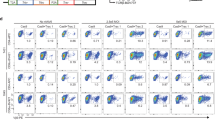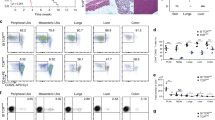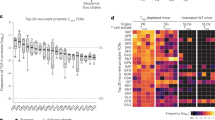Abstract
Because of tolerance mechanisms, it has been hard to identify the T cell receptors (TCRs) of high-avidity T cells against self (for example, tumor) antigens. TCRs that are specific for foreign human antigens from the nontolerant T cell repertoire can be identified in mice. Moreover, if mice are constructed to express the human TCR repertoire, they can be used to analyze the unskewed repertoire against human self antigens. Here we generated transgenic mice with the entire human TCRαβ gene loci (1.1 and 0.7 Mb), whose T cells express a diverse human TCR repertoire that compensates for mouse TCR deficiency. A human major histocompatibility class I transgene increases the generation of CD8+ T cells with human compared to mouse TCRs. Functional CD8+ T cells against several human tumor antigens were induced, and those against the Melan-A melanoma antigen used similar TCRs to those that have been detected in T cell clones from individuals with autoimmune vitiligo or melanoma. These mice will allow researchers to identify pathogenic and therapeutic human TCRs.
This is a preview of subscription content, access via your institution
Access options
Subscribe to this journal
Receive 12 print issues and online access
$209.00 per year
only $17.42 per issue
Buy this article
- Purchase on Springer Link
- Instant access to full article PDF
Prices may be subject to local taxes which are calculated during checkout




Similar content being viewed by others
References
Hedrick, S.M., Cohen, D.I., Nielsen, E.A. & Davis, M.M. Isolation of cDNA clones encoding T cell-specific membrane-associated proteins. Nature 308, 149–153 (1984).
Yanagi, Y. et al. A human T cell–specific cDNA clone encodes a protein having extensive homology to immunoglobulin chains. Nature 308, 145–149 (1984).
Chien, Y.H., Gascoigne, N.R.J., Kavaler, J., Lee, N.E. & Davis, M.M. Somatic recombination in a murine T cell receptor gene. Nature 309, 322–326 (1984).
Kisielow, P., Teh, H.S., Bluthmann, H. & von Boehmer, H. Positive selection of antigen-specific T cells in thymus by restricting MHC molecules. Nature 335, 730–733 (1988).
Sha, W.C. et al. Positive and negative selection of an antigen receptor on T cells in transgenic mice. Nature 336, 73–76 (1988).
Jameson, S.C., Hogquist, K.A. & Bevan, M.J. Positive selection of thymocytes. Annu. Rev. Immunol. 13, 93–126 (1995).
Tanchot, C., Lemonnier, F.A., Pérarnau, B., Freitas, A.A. & Rocha, B. Differential requirements for survival and proliferation of CD8 naive or memory T cells. Science 276, 2057–2062 (1997).
Zinkernagel, R.M. & Doherty, P.C. Restriction of in vitro T cell-mediated cytotoxicity in lymphocytic choriomeningitis within a syngeneic or semiallogeneic system. Nature 248, 701–702 (1974).
Zinkernagel, R.M. et al. On the thymus in the differentiation of “H-2 self-recognition” by T cells: evidence for dual recognition? J. Exp. Med. 147, 882–896 (1978).
Blackman, M. et al. The T cell repertoire may be biased in favor of MHC recognition. Cell 47, 349–357 (1986).
Zerrahn, J., Held, W. & Raulet, D.H. The MHC reactivity of the T cell repertoire prior to positive and negative selection. Cell 88, 627–636 (1997).
Marrack, P., Scott-Browne, J.P., Dai, S., Gapin, L. & Kappler, J.W. Evolutionarily conserved amino acids that control TCR-MHC interaction. Annu. Rev. Immunol. 26, 171–203 (2008).
Scott-Browne, J.P., White, J., Kappler, J.W., Gapin, L. & Marrack, P. Germline-encoded amino acids in the αβ T cell receptor control thymic selection. Nature 458, 1043–1046 (2009).
Kreslavsky, T., Gleimer, M. & von Boehmer, H. αβ versus γδ lineage choice at the first TCR-controlled checkpoint. Curr. Opin. Immunol. 22, 185–192 (2010).
Sensi, M. et al. Cytotoxic T lymphocyte clones from different patients display limited T-cell-receptor variable-region gene usage in HLA-A2–restricted recognition of the melanoma antigen Melan-A/MART-1. Proc. Natl. Acad. Sci. USA 92, 5674–5678 (1995).
Dietrich, P.-Y. et al. Melanoma patients respond to a cytotoxic T lymphocyte–defined self-peptide with diverse and nonoverlapping T-cell receptor repertoires. Cancer Res. 61, 2047–2054 (2001).
Mantovani, S. et al. Dominant TCR-α requirements for a self antigen recognition in humans. J. Immunol. 169, 6253–6260 (2002).
Trautmann, L. et al. Dominant TCR Vα usage by virus and tumor-reactive T cells with wide affinity ranges for their specific antigens. Eur. J. Immunol. 32, 3181–3190 (2002).
Mantovani, S. et al. Molecular and functional bases of self-antigen recognition in long-term persistent melanocyte-specific CD8+ T cells in one vitiligo patient. J. Invest. Dermatol. 121, 308–314 (2003).
Sherman, L.A. et al. Strategies for tumor elimination by cytotoxic T lymphocytes. Crit. Rev. Immunol. 18, 47–54 (1998).
Schumacher, T.N. T-cell-receptor gene therapy. Nat. Rev. Immunol. 2, 512–519 (2002).
Pascolo, S. et al. HLA-A2.1-restricted education and cytolytic activity of CD8+ T lymphocytes from β2 microglobulin (β2m) HLA-A2.1 monochain transgenic H-2Db β2m double knockout mice. J. Exp. Med. 185, 2043–2051 (1997).
Mombaerts, P. et al. Mutations in T cell antigen receptor genes α and β block thymocyte development at different stages. Nature 360, 225–231 (1992).
Dudley, E.C., Girardi, M., Owen, M.J. & Hayday, A.C. αβ and γ∂ T cells can share a late common precursor. Curr. Biol. 5, 659–669 (1995).
Kang, J., Volkmann, A. & Raulet, D.H. Evidence that γδ versus αβ T cell fate determination is initiated independently of T cell signaling. J. Exp. Med. 193, 689–698 (2001).
Joachims, M.L., Chain, J.L., Hooker, S.W., Knott-Craig, C.J. & Thompson, L.F. Human αβ and γδ thymocyte development: TCR gene rearrangements, intracellular TCRβ expression and γδ developmental potential—differences between men and mice. J. Immunol. 176, 1543–1552 (2006).
Kreslavsky, T., Garbe, A.I., Krueger, A. & von Boehmer, H. T cell receptor–instructed αβ versus γδ lineage commitment revealed by single-cell analysis. J. Exp. Med. 205, 1173–1186 (2008).
Burtrum, D.B., Kim, S., Dudley, E.C., Hayday, A.C. & Petrie, H.T. TCR gene recombination and αβ-γδ lineage divergence: productive TCR-β rearrangement is neither exclusive nor preclusive of γδ cell development. J. Immunol. 157, 4293–4296 (1996).
Almeida, A.R.M., Borghans, J.A.M. & Freitas, A.A. T cell homeostasis: Thymus regeneration and peripheral T cell restoration in mice with a reduced fraction of competent precursors. J. Exp. Med. 194, 591–599 (2001).
Lonberg, N. et al. Antigen-specific human antibodies from mice comprising four distinct genetic modifications. Nature 368, 856–859 (1994).
Arstila, T.P. et al. A direct estimate of the human αβ T cell receptor diversity. Science 286, 958–961 (1999).
Casrouge, A. et al. Size estimate of the αβ TCR repertoire of naïve mouse splenocytes. J. Immunol. 164, 5782–5787 (2000).
Alexander, J. et al. Derivation of HLA-A11/Kb transgenic mice: functional CTL repertoire and recognition of human A11-restricted CTL epitopes. J. Immunol. 159, 4753–4761 (1997).
Markie, D. (ed.) YAC Protocols. Meth. Mol. Biol. 54 (Humana, 1995).
Engels, B. et al. Retroviral vectors for high-level transgene expression in T lymphocytes. Hum. Gene Ther. 14, 1155–1168 (2003).
Acknowledgements
We thank M. Textor, M. Rösch, A. Gärtner and C. Westen for technical assistance; A. Garratt, E. Rohde and A. Samuels for help with ES cell culture; M. Hafner and M. Ebel for ES cell injection; H.-P. Rahn for FACS sorting; M. Gong for help with spectratyping and statistical analysis; F. Lemonier (Institut Pasteur) for HHDII mice; E. Mcintyre (Hôpital Necker) and E. Green (US National Institutes of Health) for YACs; and D. Schendel and D. Busch for critically reading the manuscript. This work was supported by grants from the Deutsche Forschungsgemeinschaft (Sonderforschungsbereich TR36) and the Helmholtz-Gemeinschaft Deutscher Forschungszentren (HA-202). W.M. was supported by the European Commission program MUGEN LSHG-CT-2005-005203 at the Helmholtz Centre for Infection Research, Braunschweig, Germany.
Author information
Authors and Affiliations
Contributions
L.-P.L. designed experimental strategies and contributed to writing of the manuscript. He contributed Figures 1c, 2a–c and 3, Supplementary Figures 3, 5–7 and 9, Table 1 and Supplementary Tables 1–3. J.C.L. contributed to experimental design and to Figures 1d and 2c, Supplementary Figure 4 and Supplementary Tables 1 and 3. X.C. contributed to Figures 2d, 3d and 4, Supplementary Figure 10 and Supplementary Table 1. C.L. contributed to Figure 4 and Supplementary Figure 8. J.P. contributed to Figure 4. W.M. was responsible for microinjection of ES cells to obtain chimeric mice. T.B. proposed and supervised the project, interpreted data and wrote the manuscript.
Corresponding author
Ethics declarations
Competing interests
The authors declare no competing financial interests.
Supplementary information
Supplementary Text and Figures
Supplementary Figures 1–10, Supplementary Tables 1–3 and Supplementary Methods (PDF 903 kb)
Rights and permissions
About this article
Cite this article
Li, LP., Lampert, J., Chen, X. et al. Transgenic mice with a diverse human T cell antigen receptor repertoire. Nat Med 16, 1029–1034 (2010). https://doi.org/10.1038/nm.2197
Received:
Accepted:
Published:
Issue Date:
DOI: https://doi.org/10.1038/nm.2197
This article is cited by
-
T cell receptor therapeutics: immunological targeting of the intracellular cancer proteome
Nature Reviews Drug Discovery (2023)
-
A systematic safety pipeline for selection of T-cell receptors to enter clinical use
npj Vaccines (2023)
-
Complete rejection of large established breast cancer by local immunochemotherapy with T cell activation against neoantigens
Cancer Immunology, Immunotherapy (2021)
-
Intracellular expression of FLT3 in Purkinje cells: implications for adoptive T-cell therapies
Leukemia (2019)
-
T Cell Receptor Profiling in Type 1 Diabetes
Current Diabetes Reports (2017)



